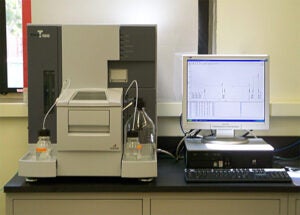 Label-free interaction analysis in real time
Label-free interaction analysis in real time
Biacore systems characterize molecules in terms of their:
- Specificity of interaction
- On and off rates (kinetics)
- Binding strength (affinity)
Biacore sensorgram
The systems also provide sensitive, accurate concentration measurements. This is based on the ability of the biomolecule of interest to interact with a specific binding partner, and may therefore be more informative than generic measurement techniques (total protein concentration for example).
No other techniques can provide such comprehensive information in real time, without the use of labels and in one system.
Application areas
- Drug discovery & development
- Biotherapeutics
- Life science research
Theory
In Biacore systems, the surface plasmon resonance (SPR) phenomenon occurs when polarized light, under conditions of total internal reflection, strikes an electrically conducting gold layer at the interface between media of different refractive index: the glass of a sensor surface (high refractive index) and a buffer (low refractive index).
A wedge of polarized light, covering a range of incident angles, is directed toward the glass face of the sensor surface. Reflected light is detected within a Biacore system. Using the surface plasmon resonance (SPR) phenomenon
An electric field intensity, known as an evanescent wave, is generated when the light strikes the glass. This evanescent wave interacts with, and is absorbed by, free electron clouds in the gold layer, generating electron charge density waves called plasmons and causing a reduction in the intensity of the reflected light.
The resonance angle at which this intensity minimum occurs is a function of the refractive index of the solution close to the gold layer on the opposing face of the sensor surface.
As molecules are immobilized on a sensor surface, the refractive index at the interface between the surface and a solution flowing over the surface changes, altering the angle at which reduced-intensity polarized light is reflected from a supporting glass plane.
The change in angle, caused by binding or dissociation of molecules from the sensor surface, is proportional to the mass of bound material and is recorded in a sensorgram.
When sample is passed over the sensor surface, the sensorgram shows an increasing response as molecules interact. The response remains constant if the interaction reaches equilibrium. When sample is replaced by buffer, the response decreases as the interaction partners dissociate. Detecting interactions in real time
Complete profiles of recognition, binding and dissociation are generated in real time. From these profiles, data such as specificity, affinity, kinetic behavior and sample concentration can be determined.
For most applications, a dextran matrix covering the gold layer enables molecules to be immobilized to a sensor surface and provides a hydrophilic environment for interactions. Surface specificity is determined by the nature of the immobilized molecule.
Since light does not penetrate the sample, interactions can be followed in colored, turbid or opaque samples. No labels are required and detection is instantaneous.
For more information go to www.biacore.com
Core Facility will help you with obtaining free downloads of manuals, tutorials and software.